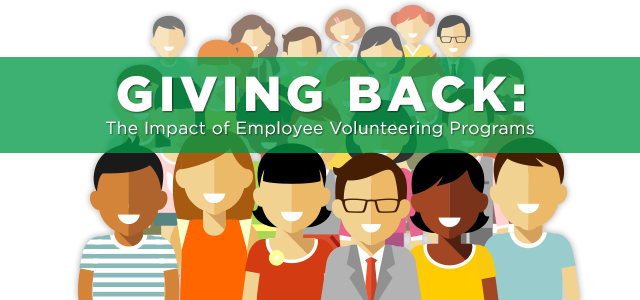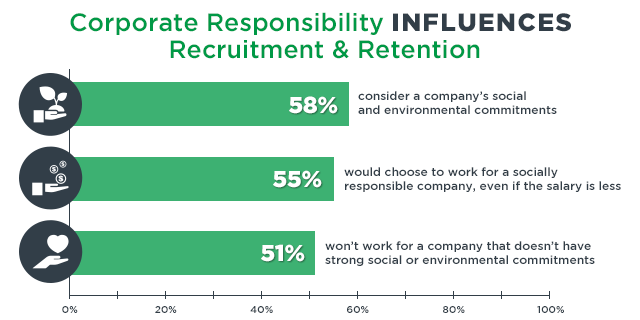
Employee volunteering programs are on the rise. Fifty-nine percent of companies surveyed in CECP’s 2015 Giving in Numbers report provided paid time for employees to volunteer in 2014, up from 54 percent in 2012.
But “there are still a significant number of companies missing out on the benefits of employee volunteer programs,” according to Sarah Ford of America’s Charities. Nonprofits “are better positioned and interested in partnering with companies and engaging with corporate employees” and continue to have a “dire need” for support.
Based on the evidence, companies with employee volunteering programs are impacting the community while appealing to prospective employees and maximizing current employees’ productivity and happiness.
Benefits of Employee Volunteering
Employee volunteer programs can produce a return on corporate investment, according to a report from Points of Light Foundation. Benefits exist in the following areas.
Employee Morale and Engagement
Community engagement activities have a positive effect on the average employee’s satisfaction and loyalty, a corporate philanthropy research initiative found. “A company’s support of employee volunteerism is a key driver directly influencing employees’ feelings about their jobs,” John Weiser and Simon Zadek wrote in the research report. The research initiative concluded that employee volunteering is a major factor influencing employee perceptions of their company — more than cash donations, in-kind contributions or nonprofit sponsorship.
In addition, people who volunteer feel better physically, mentally and emotionally, a study from UnitedHealth Group determined. As a result, employee volunteering is a “win-win activity.” Employees who volunteer are healthier and happier. And as a study published in the Academy of Management Journal explains, they have greater productivity and job satisfaction.
Employee volunteering and other social impact initiatives drive employee engagement. They are “a vital means by which to strengthen employee relationships, enhance employee morale and even build critical skill sets and expertise,” Network for Good says. “Plus, employees are hungry for ways to get involved in cause.” America’s Charities calls employee volunteer programs “the core of engagement.”
Less than one-third of U.S. workers were engaged in their jobs in 2014, according to a Gallup Poll. Approximately 18 percent are actively disengaged, costing the United States $450 billion to $550 billion in lost productivity per year. In a meta-analysis of 199 studies, Gallup found that high employee engagement increases profitability 16 percent, productivity 18 percent, customer loyalty 12 percent and quality 60 percent.
Recruiting and Retention
More than half of companies that responded to the Points of Light Foundation survey use employee volunteering to recruit and retain employees. Available research shows “clear indicators of a link” between employee volunteering programs and improved recruiting and retention.
Research from Cone Communications demonstrates the significance of corporate responsibility in people deciding which job to take.

- 58 percent consider a company’s social and environmental commitments
- 55 percent would choose to work for a socially responsible company, even if the salary is less
- 51 percent won’t work for a company that doesn’t have strong social or environmental commitments
The importance for millennial workers — who now make up the largest share of the American workforce — is even more pronounced. Two-thirds say they won’t work for a company that doesn’t have strong corporate responsibility commitments (compared to 51 percent), and they are more likely to be loyal (83 percent vs. 70 percent) when they feel they can make a positive impact on issues at work.
Among MBA graduates, more than 97 percent were willing to forgo financial benefits (up to 14 percent of their expected income) to work for a company with a better reputation for corporate responsibility and ethics, a study of graduates from 11 leading North American and European institutions found.
Development of Employee Skills
A majority of companies use employee volunteering to develop employee skills. In a Corporate Citizenship study, supervisors noted improvement in communication skills, collaboration and teamwork skills, and creative thinking skills after their employees participated in volunteer programs.
Ninety-two percent of respondents in a Deloitte survey agree that volunteering improves employees’ broader professional skill sets. The same percentage says that volunteering is an effective way to improve leadership skills, and 80 percent say that active volunteers move more easily into leadership roles.
Advance Your Business Career
Explore DegreeCompany Image Within the Community
Volunteering and corporate social responsibility have an effect on a company’s reputation. A survey of chief financial officers, investment professionals and corporate social responsibility professionals found, by a wide margin, that the most important way that environmental, social and governance programs create value is by maintaining a good corporate reputation or brand equity.
More than three-quarters of respondents in the Corporate Citizenship study believe that volunteer programs improve company image. More than half believe they help communicate a company’s values.
Implementing an Employee Volunteer Program
Structuring a Program
The foundation of an employee volunteer program can begin with four steps, a report from KPMG and Points of Light Foundation recommends.
1. Identify Business Priorities
Examine how an employee volunteer program addresses core business functions, such as recruiting and retention, marketing, public relations and productivity. First, check the organization’s mission statement, vision statement, values statement or social policy documents to see if there’s a link between business goals and support of the community. Next, conduct research to identify the organizational priorities that the employee volunteer program will support. Finally, select the benefits the organization wants from the program.
2. Identify Employees’ Interests
Tell employees about plans to develop the program and then gather information on their interests. A survey can help get a broad sense of the level of interest and preferences for causes or issues that employees want to address as well as employees’ choices for where and when to volunteer. Alternative methods include starting with employee volunteer program activities and then a survey, as well as conducting focus groups, convening brown-bag lunches or recruiting an advisory committee of employees.
3. Identify Community Needs
Uncover how social issues affect people in the community and the groups or organizations that are addressing them. See if an assessment of social, educational and economic needs has already been conducted in the community.
4. Putting It All Together
Draft a purpose statement that articulates the foundation for the employee volunteer program.
Best Practices
A report from the Business4Better conference and expo highlights seven practices of an effective employee volunteer program.
1. The Plan
An effective program has specific societal, employee and business goals with clear strategies, focused efforts and tactics to achieve them.
Example: Toyota Financial Services conducts an annual three-day retreat to craft an updated employee volunteer plan that includes vision, strategies, goals, operational improvement and priority programs. Efforts include the opportunity to earn grants for employees’ charity of choice, volunteer and learning events with executives and community leaders, and mentorship opportunities.
2. Measurement
A high-performing program measures the degree to which it is accomplishing its plan, and the results are shared internally and externally.
Example: HP measures volunteer time spent across the world from its employees. HP also collects feedback from nonprofits regarding the impact of its program and monetizes the social benefits of volunteering.
3. Design
An effective program leverages employee skills and corporate assets to align with core competencies and enhance corporate operations.
Example: Timberland views collaboration as giving back to the community and bonding employees, customers, business partners, retailers and consumers together. In 2011, 40 percent of volunteers at Timberland-sponsored service events worldwide were business partners and customers.
4. Leadership
An effective program benefits from vocal and continual support from company leadership.
Example: The Janus Foundation has a small group of senior vice president-level leaders that meets regularly to help form the employee engagement strategy. If attendance is low for an upcoming event, group members will send personal notes to encourage participation.
5. Partnerships
A high-performing program understands the importance of strategic partnerships and collaboration with government, private and nonprofit partners.
Example: Caesars Entertainment demonstrated how vital nonprofit partners are to the success of its employee volunteer program. Clean the World Foundation lacked a facility in the western United States, where many Caesars properties are located. Executive leadership at Caesars Entertainment requested grant support from Caesars’ charitable arm, Caesars Foundation, which provided $400,000 to help build and operate Clean the World’s Las Vegas recycling operations center.
6. Employee Engagement
An effective program generates employee enthusiasm, support and stewardship for the program and enriches the employee work-related experience through morale, productivity, retention and workplace skills.
Example: McKesson brings employees and their families together to create kits that provide comfort and ease to low-income patients undergoing cancer treatment. Other service opportunities support employees’ interests; for instance, employees can earn grants for their organizations by volunteering for 25 hours.
7. Success and Growth
A high-performing program recognizes, communicates and celebrates success internally and externally while continuously learning from peers, volunteers and partners and reflecting on potential program improvements.
Example: The Janus Foundation built peer-to-peer, word-of-mouth communication to advance knowledge of and excitement about their programs. It also occasionally features inspiring guest speakers at meetings. One year, Janus recognized lower participation for its holiday giving drive and decided to abandon it, instead giving employees a range of ideas to pursue together as teams. As a result, the campaign had a huge response, and employees served many different nonprofits.
Benefiting a Community and an Organization
An employee volunteer program represents one way business leaders can make a difference in the lives of others. Business policies can improve the quality of life for employees and people in the community — while adding value to the company.
Aurora University’s online MBA helps students develop skills and knowledge needed for leadership positions. In a flexible and convenient environment, the program offers a deep understanding of business concepts and what’s essential for success.







